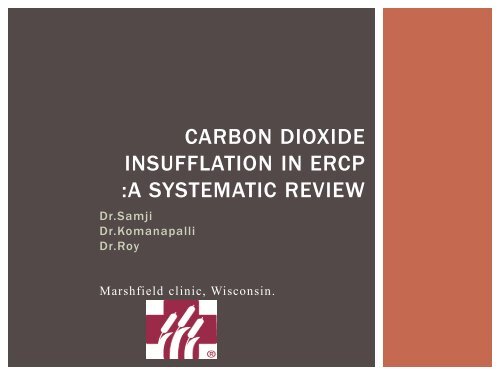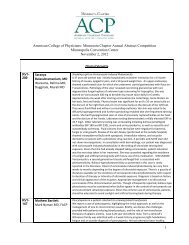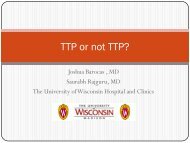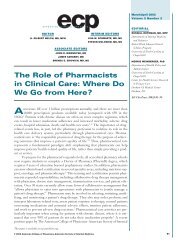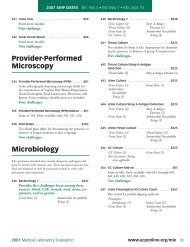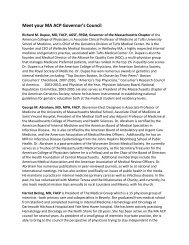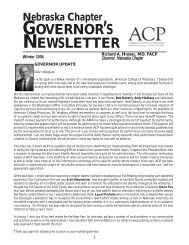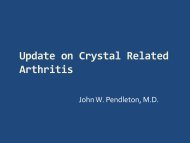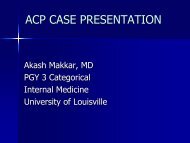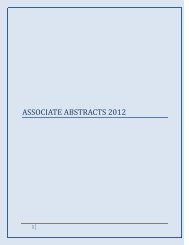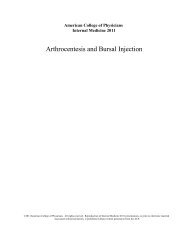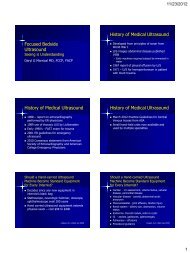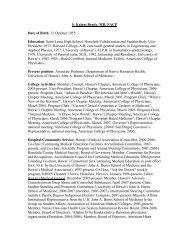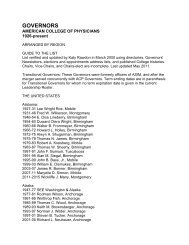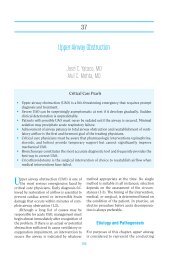Carbon dioxide insufflation in ERCP.
Carbon dioxide insufflation in ERCP.
Carbon dioxide insufflation in ERCP.
Create successful ePaper yourself
Turn your PDF publications into a flip-book with our unique Google optimized e-Paper software.
CARBON DIOXIDE<br />
INSUFFLATION IN <strong>ERCP</strong><br />
:A SYSTEMATIC REVIEW<br />
Dr.Samji<br />
Dr.Komanapalli<br />
Dr.Roy<br />
Marshfield cl<strong>in</strong>ic, Wiscons<strong>in</strong>.
INTRODUCTION<br />
• <strong>ERCP</strong> is a valuable technique used as a<br />
diagnostic and therapeutic option for many<br />
pancreatic and biliary pathologies.<br />
• Air <strong><strong>in</strong>sufflation</strong> is used for <strong><strong>in</strong>sufflation</strong> of<br />
duodenum.<br />
• Abdom<strong>in</strong>al pa<strong>in</strong> and nausea are the non<br />
specific compla<strong>in</strong>ts of <strong>ERCP</strong>
• <strong>Carbon</strong> <strong>dioxide</strong> is easily absorbed and<br />
excreted compared to air.<br />
• So carbon <strong>dioxide</strong> was thought to decrease<br />
abdom<strong>in</strong>al distension there by decrease<br />
abdom<strong>in</strong>al pa<strong>in</strong>.
AIMS OF THE STUDY<br />
• To compare the effect of carbon <strong>dioxide</strong> to<br />
air <strong><strong>in</strong>sufflation</strong> <strong>in</strong> <strong>ERCP</strong>.<br />
• To assess the safety of carbon <strong>dioxide</strong><br />
<strong><strong>in</strong>sufflation</strong> <strong>in</strong> <strong>ERCP</strong>.
OUTCOMES<br />
• Post procedural abdom<strong>in</strong>al pa<strong>in</strong><br />
• Post procedural abdom<strong>in</strong>al distension<br />
• Dose of sedation<br />
• Safety of carbon <strong>dioxide</strong> <strong><strong>in</strong>sufflation</strong>.
SEARCH STRATEGY<br />
• PubMed, Medl<strong>in</strong>e, Cochrane database and recent<br />
abstracts from major conference proceed<strong>in</strong>gs were<br />
searched.<br />
• RCT’s compar<strong>in</strong>g role of CO2 and air <strong><strong>in</strong>sufflation</strong> <strong>in</strong><br />
<strong>ERCP</strong> were <strong>in</strong>cluded.<br />
• Standard forms were used to extract data by two<br />
<strong>in</strong>dependent reviewers.<br />
• We <strong>in</strong>cluded all the studies that compared CO2 to Air<br />
<strong><strong>in</strong>sufflation</strong> <strong>in</strong> <strong>ERCP</strong> through 7/2012.
2625 Publications<br />
2620 excluded<br />
5 RCT <strong>in</strong>cluded<br />
3 abstracts<br />
<strong>in</strong>cluded<br />
2 RCT 1 Retrospective
GENERAL DESCRIPTION OF STUDIES<br />
• 8 studies were <strong>in</strong>cluded <strong>in</strong> our systematic review.7<br />
studies are randomized double bl<strong>in</strong>ded control trials and<br />
1 study is retrospective study.<br />
• Total number of 925 patients are <strong>in</strong>cluded <strong>in</strong> 8 studies.<br />
• No significant difference <strong>in</strong> patient population noted.
INCLUSION CRITERIA<br />
• Adult pts. requir<strong>in</strong>g <strong>ERCP</strong>.
EXCLUSION CRITERIA<br />
• No consent<br />
• Age < 20 years<br />
• Significant pre procedural abdom<strong>in</strong>al pa<strong>in</strong><br />
• Patients with COPD.<br />
• Pregnant patients<br />
• Chronic use of narcotics-long act<strong>in</strong>g opioid daily more<br />
than 45 days.<br />
• Acute pancreatitis<br />
• Poor health status.<br />
• One study <strong>in</strong>cluded patients with COPD without CO2 retention<br />
or requir<strong>in</strong>g oxygen, CAD,OSA.(Dellon etal)
GENERAL CHARECTERISTICS<br />
NAME OF STUDY Number of patients AGE Sex(female) CO2 DELIVERY PROCEDURE TIME<br />
CO 2 AIR CO 2 AIR CO 2 AIR CO 2 AIR<br />
Brettheur etal 58 58 57+16 54+18 72% 62% OLYMPUS ECR 43+27 48+25<br />
Dellon etal 36 38 60.1+15 59.7+16.6 47% 50% OLYMPUS ECR 39.3 35.1<br />
Lugiano etal 37 39 66.1+14.6 67.1+16.4 59% 53% E Z EM <strong>in</strong>c 34.1+17.8 37.3+17.6<br />
Maple etal 50 50 57 51.7 52% 50% E Z EM INC 31.1 31.6<br />
kutawani etal 40 40 66.1+9.8 68.7+10.9 37% 40% OLYMPUS ECR 45+24.75 43+22.4<br />
Arjunan etal 147 151<br />
sweel<strong>in</strong>chen etal 34 27 58.4 58.4<br />
Bhalme etal 60 60 29 33
EFFECT ON POST PROCEDURAL<br />
ABDOMINAL PAIN<br />
• Abdom<strong>in</strong>al pa<strong>in</strong> was measured by different scales<br />
and at different po<strong>in</strong>t of times.<br />
• No significant difference <strong>in</strong> pre procedural<br />
abdom<strong>in</strong>al pa<strong>in</strong> .
Kutawani Brettheur Lugiano Sweel<strong>in</strong>chen Dellon Arjunan<br />
Maple<br />
Bhalme<br />
CO 2 AIR CO 2 AIR CO2 AIR CO 2 AIR CO 2 AIR CO 2 AIR CO 2 AIR CO 2 AIR<br />
Pa<strong>in</strong> scale<br />
VAS 10 po<strong>in</strong>t VAS 100 mm VAS 100mm VAS 10 po<strong>in</strong>t VAS 100mm VAS 1-10cm VAS 10 po<strong>in</strong>t<br />
VAS 10 po<strong>in</strong>t<br />
pre procedure<br />
Not significant<br />
15 15 5.7+5.4 6.2+6.7 0.38 1.51 12.8+19.6 10.5+21.0 Not significant 0.5 0.48<br />
1 hour<br />
5 19 10+4.4 35+12 0.38 0.37 16.4+25.2 10.8+19.3 0.61+0.67 0.84+0.95 0.7 1.9 0% 10%<br />
3 hours<br />
6 hours<br />
1.4+2 0.9+2 7 21 8+2.5 28.1+9.6 20.8+32.2 22.3+27.8 28% 48%<br />
10 22 7+2.5 14.1+4.7 18.3+25.4 19.5+26.7 28% 48%<br />
24 hours<br />
1.1+1.9 0.5+1.3 4 20 4.2+3.4 5+2.8 15.0+24.7 15.5+24.0<br />
Not significant
• Post procedural abdom<strong>in</strong>al pa<strong>in</strong> was less <strong>in</strong><br />
carbon <strong>dioxide</strong> group till 6 hours after<br />
procedure.<br />
• There was no significant difference between 2<br />
groups 24 hours after procedure.
EFFECT ON POST PROCEDURAL ABDOMINAL<br />
DISTENSION<br />
Kutawani Breetheur Lugiano Dellon Arjunan Maple<br />
SCALE GVS-Xray Xray VAS100mm abd girth-cm Abd girth cm Abd girth-cm<br />
CO 2 AIR CO 2 AIR CO 2 AIR CO 2 AIR CO 2 AIR CO 2 AIR<br />
Pre procedure<br />
0.11+0.04 0.10+0.05 4.2+3.4 4.5+3.7 101.5+15 105.5+16<br />
Post procedure<br />
Rate of <strong>in</strong>crease<br />
0.14+0.06 0.31+0.11 13% 29% 8.8+5.3 31.7+19.2 102.2+14 106.2+17.4<br />
3.8+5.9 21.0+11.1 0.7+3.8 0.8+4.8 0.69+1.12 1.02+1.32 0.3 2.1
• 4 out of 6 studies noticed significant decrease<br />
<strong>in</strong> abdom<strong>in</strong>al distension <strong>in</strong> CO2 group compared<br />
to air group.<br />
• 1 study noticed that 29% patients <strong>in</strong> air group<br />
had moderate to severe distension compared to<br />
13% <strong>in</strong> CO2 group.
EFFECT ON DOSE OF SEDATION<br />
Kutawani Breetheur Dellon Bhalme Lugiano Sweel<strong>in</strong> Maple<br />
CO 2 AIR CO 2 AIR CO 2 AIR CO 2 AIR<br />
Type of sedation fentanyl,midazolam Midazolam,pethid<strong>in</strong>eFentanyl,midazolam Fentanyl,midazolam Propofol Propofol Propofol<br />
Fentanyl (mcg) 115+48.9 130+53.5 155.6 162.2 75 75<br />
Pethid<strong>in</strong>e (mg) 54.4+24.5 38.5+11.1 35.2+27.9 44.0+37.3<br />
Midazolam(mg) 7.3+3.6 8.4+3.7 6.3+3.6 6.4+2.8 9.1 10.7 4 4.5<br />
Diazepam (mg) 2+0.8 2+0<br />
Scopolam<strong>in</strong>e <strong>in</strong>e(mg) 23+6.6 20.6+2.4<br />
Promethaz<strong>in</strong>e z<strong>in</strong>e(mg) 17 25<br />
Glucagon (mg) 1.2+0.4 1.1+0.2 0.5 0.3
• No significant difference <strong>in</strong> dose of sedation<br />
used between 2 groups<br />
• No significant difference <strong>in</strong> dose of<br />
antispastic drugs used.
SAFETY OF CARBON DIOXIDE<br />
INSUFFLATION<br />
Kutawani Brettheur Lugiano Dellon Arjunan Maple Bhalme<br />
Co2 monitor<strong>in</strong>g SPO 2 SPCO 2 PETCO 2 SPCO 2 PETCO 2 SPO2 SPO2<br />
CO 2 AIR CO 2 AIR CO 2 AIR CO 2 AIR CO 2 AIR<br />
Basel<strong>in</strong>e 97.8+1.3 97.7+1.3 NS NS 29.8+1.8 30+1.6 40.5 40.3<br />
Post procedure<br />
97.1+1.4 96.6+1.3 NS NS 32.6+2.6 30.7+1.3 46.1 45.2 NS NS<br />
Maximum CO 2<br />
32.6+2.6 30.7+1.3 50 48.7
• No significant respiratory depression or<br />
respiratory complications noted with CO2<br />
<strong><strong>in</strong>sufflation</strong>.<br />
• No significant adverse events or complications<br />
noted <strong>in</strong> CO2 group compared to air group.
CONCLUSIONS<br />
• <strong>Carbon</strong> <strong>dioxide</strong> <strong><strong>in</strong>sufflation</strong> <strong>in</strong> <strong>ERCP</strong> can reduce post<br />
procedural abdom<strong>in</strong>al pa<strong>in</strong> and the effect lasts till 6<br />
hours after procedure.<br />
• Abdom<strong>in</strong>al distension was less <strong>in</strong> carbon <strong>dioxide</strong> group<br />
compared to air group.<br />
• There was no significant difference <strong>in</strong> dose of sedation<br />
and dose of antispastic drugs used.
• <strong>Carbon</strong> <strong>dioxide</strong> <strong><strong>in</strong>sufflation</strong> is found to be safe <strong>in</strong><br />
<strong>ERCP</strong><br />
• Safety still needs to be established <strong>in</strong> patients<br />
with COPD, obstructive sleep apnea, morbid<br />
obesity, patients who has multiple co morbid<br />
conditions and medically unstable patients.


